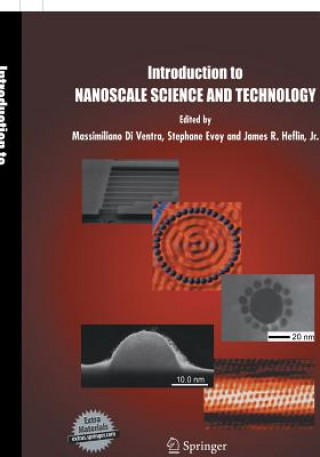
Kód: 01418153
Introduction to Nanoscale Science and Technology
Autor Massimiliano di Ventra, Stephane Evoy, James R. Heflin
From the reviews:§"...A class in nanoscale science and technology is daunting for the educator, who must organize a large collection of materials to cover the field, and for the student, who must absorb all the new concepts. This ... celý popis
- Jazyk:
 Angličtina
Angličtina - Vazba: Pevná
- Počet stran: 611
Nakladatelství: Springer-Verlag New York Inc., 2004
- Více informací o knize

4798 Kč

Skladem u dodavatele v malém množství
Odesíláme za 12-15 dnů
Potřebujete více kusů?Máte-li zájem o více kusů, prověřte, prosím, nejprve dostupnost titulu na naši zákaznické podpoře.
Přidat mezi přání
Mohlo by se vám také líbit
-

Nanoscaled Semiconductor-on-Insulator Structures and Devices
6578 Kč -

Modern Nucleophilic Aromatic Substitution
5781 Kč -

Invitation to Think and Feel Differently in the New Millennium
617 Kč -

Babys erstes Jahr
505 Kč -

Meranie a modelovanie elektrických strojov
302 Kč -

Daytime Shooting Star. Bd.5
188 Kč -

Gärten für Kinder
745 Kč
Dárkový poukaz: Radost zaručena
- Darujte poukaz v libovolné hodnotě a my se postaráme o zbytek.
- Poukaz se vztahuje na celou naši nabídku.
- Elektronický poukaz vytisknete z e-mailu a můžete ihned darovat.
- Platnost poukazu je 12 měsíců od data vystavení.
Více informací o knize Introduction to Nanoscale Science and Technology
Nákupem získáte 480 bodů
 Anotace knihy
Anotace knihy
From the reviews:§"...A class in nanoscale science and technology is daunting for the educator, who must organize a large collection of materials to cover the field, and for the student, who must absorb all the new concepts. This textbook is an excellent resource that allows students from any engineering background to quickly understand the foundations and exciting advances of the field. The example problems with answers and the long list of references in each chapter are a big plus for course tutors. The book is organized into seven sections. The first, nanoscale fabrication and characterization, covers nanolithography, self-assembly, and scanning probe microscopy. Of these, we enjoyed the section on nanolithography most, as it includes many interesting details from industrial manufacturing processes. The chapter on self-assembly also provides an excellent overview by introducing six types of intermolecular interactions and the ways these can be employed to fabricate nanostructures. The second section covers nanomaterials and nanostructures. Out of its 110 pages, 45 are devoted to carbon nanotubes. Fullerenes and quantum dots each have their own chapter that focuses on the properties and applications of these nanostructures. Nanolayer, nanowire, and nanoparticle composites of metals and semiconductors are briefly covered (just 12 pages), with slightly more discussion of specific applications. The section on nanoscale electronics begins with a history of microelectronics before discussing the difficulties in shrinking transistor size further. The discussion of problems (leakage current, hot electrons, doping fluctuations, etc.) and possible solutions (high- k dielectrics, double-gate devices) could easily motivate deeper discussions of nanoscale electrical transport. A chapter on molecular electronics considers transport through alkanes, molecular transistors, and DNA in a simple, qualitative manner we found highly instructive. Nanoscale magnetic systems are examined in the fourth section. The concept of quantum computation is nicely presented, although the discussion of how this can be achieved with controlled spin states is (perhaps necessarily) not clear. We found the chapter on magnetic storage to be one of the most lucid in the book. The giant magnetoresistive effect, operation of spin valves, and issues in magnetic scaling are easier to understand when placed in the context of the modern magnetic hard disk drive. Micro- and nanoelectromechanical systems are covered with an emphasis on the integration of sensing, computation, and communication. Here, the student can see advanced applications of lithography. The sixth section, nanoscale optoelectronics, describes quantum dots, organic optoelectronics, and photonic crystals. The chapter on organic optoelectronics is especially clear in its discussion of the fundamentals of this complicated field. The book concludes with an overview of nanobiotechnology that covers biomimetics, biomolecular motors, and nanofluidics. Because so many authors have contributed to this textbook, it suffers a bit from repetition. However, this also allows sections to be omitted without any adverse effect on student comprehension. We would have liked to see more technology to balance the science; apart from the chapters on lithography and magnetic storage, little more than an acknowledgment is given to commercial applications. Overall, this book serves as an excellent starting point for the study of nanoscale science and technology, and we recommend it to anyone with a modest scientific background. It is also a great vehicle to motivate the study of science at a time when interest is waning. Nanotechnology educators should look no further." (MATERIALS TODAY, June 2005)
 Parametry knihy
Parametry knihy
4798 Kč
- Plný název: Introduction to Nanoscale Science and Technology
- Autor: Massimiliano di Ventra, Stephane Evoy, James R. Heflin
- Jazyk:
 Angličtina
Angličtina - Vazba: Pevná
- Počet stran: 611
- EAN: 9781402077203
- ISBN: 1402077203
- ID: 01418153
- Nakladatelství: Springer-Verlag New York Inc.
- Hmotnost: 1138 g
- Rozměry: 263 × 189 × 38 mm
- Datum vydání: 30. June 2004
Oblíbené z jiného soudku
-

Dune
216 Kč -

Haunting Adeline
621 Kč -

Berserk Deluxe Volume 2
1092 Kč -

White Nights
90 Kč -

Powerless
291 Kč -

Atomic Habits
330 Kč -

Dune Messiah
228 Kč -

Berserk Deluxe Volume 3
1142 Kč -

One Day
221 Kč -

Berserk Deluxe Volume 1
1115 Kč -

Iron Flame
368 Kč -

Surrounded by Idiots
213 Kč -

Harry Potter and the Prisoner of Azkaban (Minalima Edition)
993 Kč -

Gravity Falls Journal 3
443 Kč -

Heaven Official's Blessing: Tian Guan Ci Fu (Novel) Vol. 1
440 Kč -

The Creative Act
568 Kč -

Dune
276 Kč -

Hunting Adeline
624 Kč -

A Little Life
291 Kč -

Children of Dune
230 Kč -

Heaven Official's Blessing: Tian Guan Ci Fu (Novel) Vol. 2
426 Kč -

Bungo Stray Dogs, Vol. 8 (light novel)
379 Kč -

Percy Jackson and the Olympians 5 Book Paperback Boxed Set
944 Kč -

Solo Leveling, Vol. 1
440 Kč -

The Prisoner's Throne
191 Kč -

Court of Thorns and Roses
268 Kč -

Cry Baby Coloring Book
276 Kč -

Fourth Wing
321 Kč -

Icebreaker
199 Kč -

Berserk Deluxe Volume 6
1089 Kč -

Avatar, the Last Airbender: The Kyoshi Novels (Box Set)
986 Kč -

The 48 Laws of Power
601 Kč -

House of Leaves
462 Kč -

Twisted Lies
213 Kč -

Dune Messiah
214 Kč -

No Longer Human
317 Kč -

48 Laws Of Power
331 Kč -

Twisted Games
213 Kč -

Caraval Paperback Boxed Set
902 Kč -

Solo Leveling, Vol. 2
437 Kč -

Open Circuits
907 Kč -

Berserk Deluxe Volume 5
1119 Kč -

Heaven Official's Blessing: Tian Guan Ci Fu (Novel) Vol. 3
414 Kč -

Berserk Deluxe Volume 4
1292 Kč -

Court of Mist and Fury
206 Kč -

SOLO LEVELING V08
436 Kč -

English File Upper Intermediate Multipack A (4th)
531 Kč -

CHAINSAW MAN V14
251 Kč -

Before the Coffee Gets Cold
184 Kč
Osobní odběr Praha, Brno a 12903 dalších
Copyright ©2008-24 nejlevnejsi-knihy.cz Všechna práva vyhrazenaSoukromíCookies


 Vrácení do měsíce
Vrácení do měsíce 571 999 099 (8-15.30h)
571 999 099 (8-15.30h)